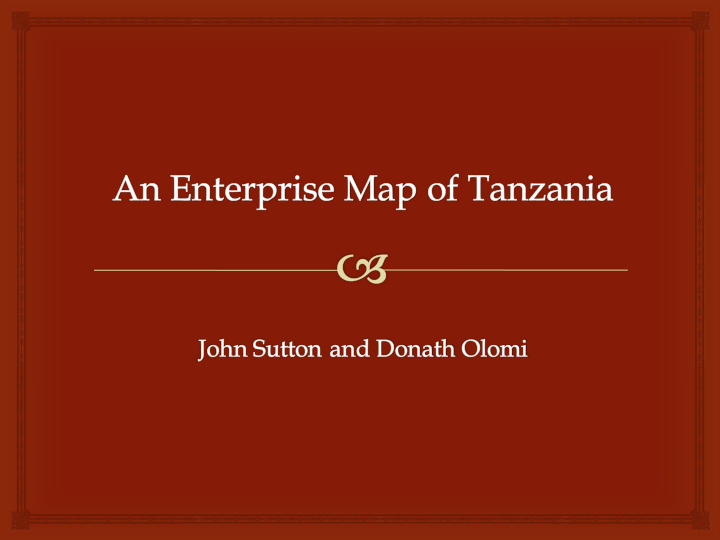



2
Lack of adequate and uniform description of the capabilities of existing enterprises Need for discussions of enterprise policy to be grounded in a shared, correct understanding of this 3
Cost and Timescale of full surveys What surveys do not capture The body of knowledge in advanced industrial economies The limited but specific information that is important to policy analysis Towards a design that is fast and inexpensive 4
Profile each of the major industries Excludes services and financial sector Profile the leading firms in each industry (History, origins, current capabilities, etc.) Identify clusters of mid-size firms and their activities Problems and challenges 5
Profile 50 ‘Leading Firms’ distributed across these key industries Industry profile includes brief profiles of a few representative mid-size firms in each sub-market 6
36% of exports in 2011 came from Gold. No other single industry has a dominant role 10 industries account for half of exports [Gold, Cashews, Fish Processing, Coffee, Tobacco, Tea, Flour, Steel, Palm Oil, Cut Flowers] 22 firms account for over half of exports in 7 of these 10 industries; all of exports in another, and one-third of exports in the other two. These 22 firms account for over half of Tanzania’s exports 7
Figure 1. An export map. (‘a’, Aluminium Africa; ‘b’, Tanzania Steel Pipes; ‘c’, Neelkanth; ‘d’, Nyakato SteelMills; ‘e’, Kiliflora; ‘f’, Tanzania Flowers) 8
Can Tanzania’s Growth rate be sustained ? And if so How??? 9
Tanzania’s Economy has had really strong growth performance over the past decade The good news is that this growth has been broadly based across sectors 10
Figure 2. The change in size and composition of Tanzania’s GDP, 2000–2010. (‘Wholesale, retail, etc’ covers wholesale, retail trade, restaurants and hotels. 11 ‘Transport, etc’ covers transport, storage and communication.)
Figure 3. The changing size and composition of Tanzania’s exports, 1997–2010. 12
If this continues, Tanzania can become a middle income country in a decade or so But can it continue? And How? ………. 13
Some contributions are not of a continuing nature Two factors will be key in sustaining growth 14
Oil and Gas Sector Domestic Industry These must be linked 15
Problems with attracting FDI South Africa, Canada and the UK account for half the FDI stock A quarter of FDI goes to manufacturing The UK, US and Kenya are the leading sources of manufacturing FDI The key contribution of FDI How the Oil and Gas Sector can draw in FDI… But really careful management is crucial if benefits to local industry are to flow 16
What is in the book? What are the themes? How is it arranged? 17
Steel, Engineering and Assembly Sub-markets include: A : Galvanized coil/sheet, Corrugated sheet, Re-bars etc. B: Engineering products, Car/Truck bodies, etc. C: Hand Tools and other final products 18
Basic information on size, product range, ownership, etc First focus : where capabilities came from Second focus: Supply chains…inputs, origin by category; sales, what and to whom. 19
What can be locally sourced ? What can be locally sold ? Development of enterprises and development of domestic supply chains Development of enterprises within international supply chains Two faces of supply chains 20
Home grown successes (Bharat Forge) From Trading to Manufacturing ( Steel Wire in Zambia) From Equipment Suppliers ( Packaged Orange Juice in Ethiopia) From Supply Chains (Auto Components in India) 21
Figure 4. Origins of Tanzania’s leading industrial companies. 22
Of the 29 domestic private sector Leaders 12 had their origin in Trading…. And 14 were industrial start-ups 23
What do we know of such ventures in other parts of the world? Are Tanzanian concerns special to Tanzania? 24
It is seen as disappointing in Tanzania that so few local start-ups grow to become mid-size industrial companies…. Is this surprising? Special to Tanzania? Lessons from elsewhere: a standard pattern. A story from the US: When DO small firms grow? 25
Domestic Industrial companies need a supportive policy environment… Access to Land Anna Temu; Kamal Steel 26
Home grown successes (Bharat Forge, India) From Trading to Manufacturing (Steel Wire , Ethiopia) From Equipment Suppliers (Packaged Orange Juice, Ghana) From Supply Chains (Auto Components , China) The key nexus: harnessing FDI 27
Cement, Beer, Wood Furniture, etc. Clothing and Textiles…a special case International supply chains What REALLY happened to Indian and Chinese industry? 28
What the oil and gas sector can bring Integration of local firms into international supply chains How easy it is to go wrong 29
Columbia as a success story Tipiel now does engineering design for Italian clients PTS took over Well Testing from Schlumberger/Haliburton Equipo took over Plant Maintenance from Wood Group Angolan achievements Disappointments in Azerbaijan 30
The key to success lies in having a deep understanding of existing industrial capabilities It is crucial to focus on narrowly defined sectors which offer long term viability It is hopeless to expect a large number of ventures 31
It is vital to have a fair and open process But it is no less important to carefully design criteria for Approved Vendor status in the light of a deep understanding of Tanzania’s existing industrial capabilities 32
See the Chapter on Steel, Engineering and Assembly for Tanzania’s potential recruits in the construction of Rigs and Terminals See the chapter on Food Processing for leading potential suppliers And see also how, as in Columbia, new forms of sophisticated services can boom. 33
If oil industry supply chains can be fully integrated with Tanzania’s domestic industrial sector , then the payoff to medium term growth will be huge… No single issue in Enterprise policy is more important right now….. 34
Recommend
More recommend